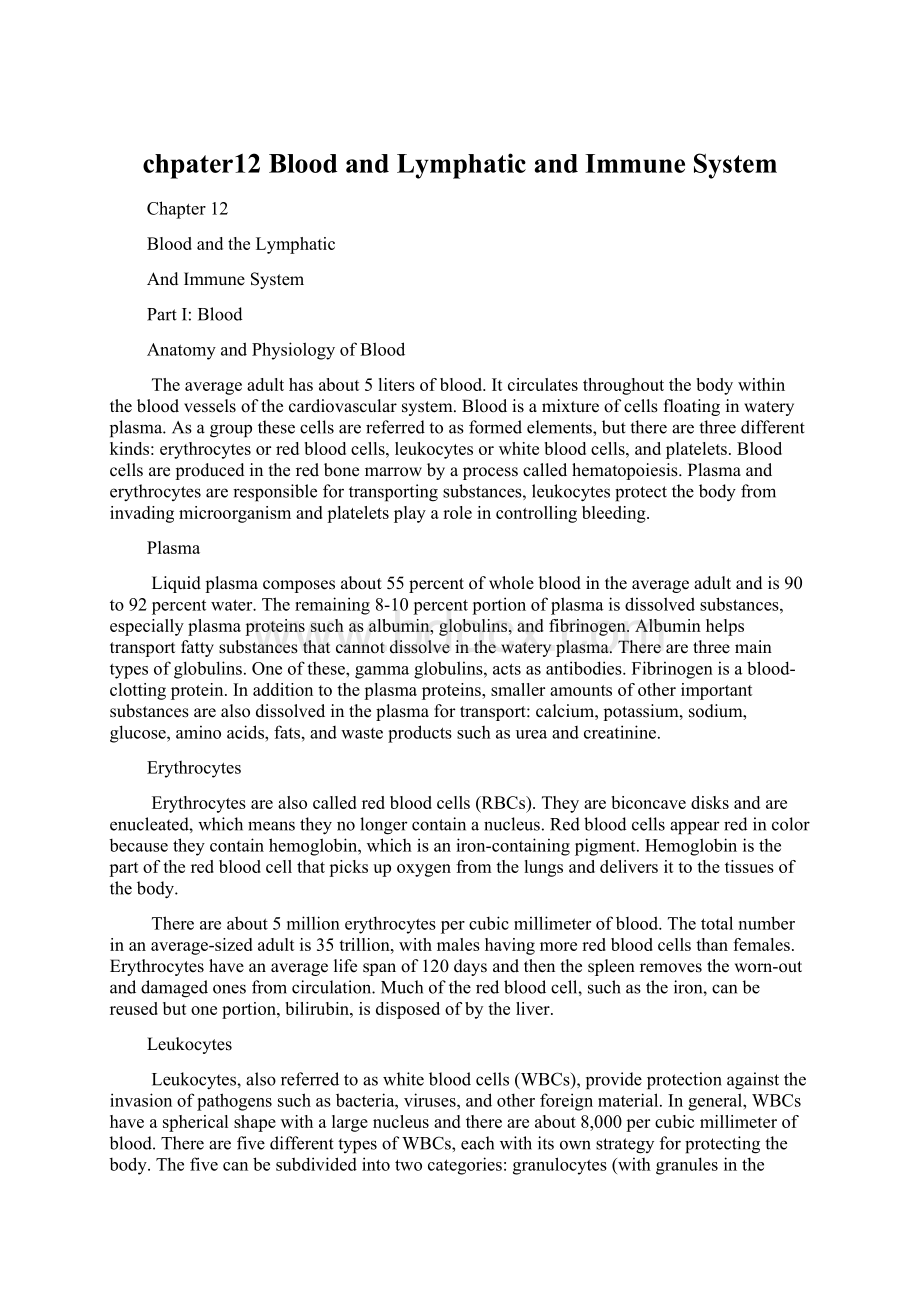chpater12 Blood and Lymphatic and Immune System.docx
《chpater12 Blood and Lymphatic and Immune System.docx》由会员分享,可在线阅读,更多相关《chpater12 Blood and Lymphatic and Immune System.docx(22页珍藏版)》请在冰豆网上搜索。

chpater12BloodandLymphaticandImmuneSystem
Chapter12
BloodandtheLymphatic
AndImmuneSystem
PartI:
Blood
AnatomyandPhysiologyofBlood
Theaverageadulthasabout5litersofblood.Itcirculatesthroughoutthebodywithinthebloodvesselsofthecardiovascularsystem.Bloodisamixtureofcellsfloatinginwateryplasma.Asagroupthesecellsarereferredtoasformedelements,buttherearethreedifferentkinds:
erythrocytesorredbloodcells,leukocytesorwhitebloodcells,andplatelets.Bloodcellsareproducedintheredbonemarrowbyaprocesscalledhematopoiesis.Plasmaanderythrocytesareresponsiblefortransportingsubstances,leukocytesprotectthebodyfrominvadingmicroorganismandplateletsplayaroleincontrollingbleeding.
Plasma
Liquidplasmacomposesabout55percentofwholebloodintheaverageadultandis90to92percentwater.Theremaining8-10percentportionofplasmaisdissolvedsubstances,especiallyplasmaproteinssuchasalbumin,globulins,andfibrinogen.Albuminhelpstransportfattysubstancesthatcannotdissolveinthewateryplasma.Therearethreemaintypesofglobulins.Oneofthese,gammaglobulins,actsasantibodies.Fibrinogenisablood-clottingprotein.Inadditiontotheplasmaproteins,smalleramountsofotherimportantsubstancesarealsodissolvedintheplasmafortransport:
calcium,potassium,sodium,glucose,aminoacids,fats,andwasteproductssuchasureaandcreatinine.
Erythrocytes
Erythrocytesarealsocalledredbloodcells(RBCs).Theyarebiconcavedisksandareenucleated,whichmeanstheynolongercontainanucleus.Redbloodcellsappearredincolorbecausetheycontainhemoglobin,whichisaniron-containingpigment.Hemoglobinisthepartoftheredbloodcellthatpicksupoxygenfromthelungsanddeliversittothetissuesofthebody.
Thereareabout5millionerythrocytespercubicmillimeterofblood.Thetotalnumberinanaverage-sizedadultis35trillion,withmaleshavingmoreredbloodcellsthanfemales.Erythrocyteshaveanaveragelifespanof120daysandthenthespleenremovestheworn-outanddamagedonesfromcirculation.Muchoftheredbloodcell,suchastheiron,canbereusedbutoneportion,bilirubin,isdisposedofbytheliver.
Leukocytes
Leukocytes,alsoreferredtoaswhitebloodcells(WBCs),provideprotectionagainsttheinvasionofpathogenssuchasbacteria,viruses,andotherforeignmaterial.Ingeneral,WBCshaveasphericalshapewithalargenucleusandthereareabout8,000percubicmillimeterofblood.TherearefivedifferenttypesofWBCs,eachwithitsownstrategyforprotectingthebody.Thefivecanbesubdividedintotwocategories:
granulocytes(withgranulesinthecytoplasm)andagranulocytes(withoutgranulesinthecytoplasm).ThenameandfunctionofeachtypeispresentedinTable12.1.
Table12.1LeukocyteClassification
Leukocyte
Function
Granulocytes
Basophils
Releasehistamineandheparintodamagedtissues
Eosinophils
Destroyparasitesandincreaseduringallergicreactions
Neutrophils
Importantforphagocytosis:
mostnumerousoftheleukocytes
Agranulocytes
Monocytes
Importantforphagocytosis
Lymphocytes
Provideprotectionthroughanimmunityacivity
Platelets
Plateletisthemoderntermforthrombocyte.Plateletsarethesmallestofalltheformedbloodelements.Theyarealsonotwholecells,butratherareformedwhenthecytoplasmofalargeprecursorcellshattersintosmallplate-likefragments.Therearebetween200,000and300,000percubicmillimeterinthebody.
Plateletsplayacriticalpartintheblood-clottingprocessorhemostasis.Theyagglutinateorclumptogetherintosmallclusterswhenabloodvesseliscutordamaged.Plateletsreleaseasubstancecalledthromboplastin,which,inthepresenceofcalcium,reactswithprothrombintoformthrombin.Thenthrombin,inturn,workstoconvertfibrinogentofibrin,whicheventuallybecomesthemesh-likebloodclot.SeeFigure12.1.
Figure12.1CompositionofBlood
Table12.2CompositionofBlood
Plasma55%
Constituent
Majorfunctions
Water
Solventforcarryingothersubstances
Salts
Sodium,Potassium,Calcium,Magnesium,Chloride,Bicarbonate
Osmoticbalance,pHbuffering,andregulationofmembranepermeability
Plasmaproteins
Albumin
Fibrinogen
Globulins
Osmoticbalance,pHbuffering
Clottingofblood
Defense(antibodies)andlipidtransport
Substancestransportedbyblood
Nutrients(e.g.,glucose,fattyacids,vitamins,aminoacids)
Wasteproductsofmetabolism(urea,uricacid)
Respiratorygases(O2andCO2)
Hormones
FormedElements(CellularComponents)45%
Celltype
Number(permm3ofblood)
Functions
Erythrocytes
(redbloodcells)
4-6million
Transportoxygenandhelptransportcarbondioxide
Leukocytes
(whitebloodcells)
4000-11,000
Defenseandimmunity
Platelets
250,000-500,000
Bloodclotting
BloodTyping
Eachperson’sbloodisdifferentfromothers’duetothepresenceofmarkerproteinsonthesurfaceofhisorhererythrocytes.Beforeapersonreceivesabloodtransfusionitisimportanttodoabloodtyping.Thisisalaboratorytesttodetermineifthedonatedbloodiscompatiblewiththerecipient’sblood.Therearemanydifferentsubgroupsofbloodmarkers,butthetwomostimportantonesaretheABOsystemandRhfactor.
ABOSystem
IntheABObloodsystemtherearetwopossibleRBCmarkers,AandB.ApersonwithanAmarkerissaidtohavetypeAblood.TypeAbloodproducesanti-Bantibodies.ThepresenceofaBmarkergivestypeBbloodandanti-Aantibodies.TheabsenceofeitheranAoraBmarkerresultsintypeOblood,whichcontainsbothanti-Aandanti-Bantibodies.Ifbothmarkersarepresent,thebloodistypeABanddoesnotresultinanyantibodies.
BecausetypeOblooddoesnothaveeithermarkerAorB,itwillnotreactwithanti-Aoranti-Bantibodies.ForthisreasonapersonwithtypeObloodisreferredtoasauniversaldonor.Inanemergency,typeObloodmaybegiventoapersonwithanyoftheotherbloodtypes.Similarly,typeABbloodistheuniversalrecipient.ApersonwithtypeABbloodhasnoantibodiesagainsttheotherbloodtypesand,therefore,inanemergency,canreceiveanytypeofblood.SeeTable12.3.
Table12.3ABOSystem
ABO
BloodType
Antigen
A
Antigen
B
Antibody
anti-A
Antibody
Anti-B
A
yes
no
no
yes
B
no
yes
yes
no
O
no
no
yes
yes
AB
yes
yes
no
no
RhFactor
RhfactorisnotasdifficulttounderstandastheABOsystem.ApersonwithRhfactoronhisorherredbloodcellsissaidtobeRh-positive(Rh+).Sincethispersonhasthefactor,heorshewillnotmakeanti-Rhantibodies.ApersonwithouttheRhfactorisRh-negative(Rh-)andwillproduceanti-Rhantibodies.Therefore,anRh+personmayreceivebothanRh+andanRh-transfusion,butanRh-personcanreceiveonlyRh-blood.
PartII:
TheLymphaticandImmuneSystem
AnatomyandPhysiology
OftheLymphaticandImmuneSystem
Thelymphaticandimmunesystemsconsistofanetworkoflymphaticvessels,lymphnodes,spleen,thymusgland,andtonsils.Thissystemperformsseveralquitediversefunctionsforthebody.First,itcollectsexcesstissuefluidthroughoutthebodyandreturnsittothecirculatorysystem,purifyingitasitpassesthroughthesystem.Fluidwithinlymphaticvesselsisreferredtoaslymph.Lymphiscomposedofwater,whitebloodcells,nutrients,hormones,saltscarbondioxide(CO2),oxygen(O2),andurea.Therefore,thissystemassiststhecirculatorysystemintransportingsubstancesthroughoutthebody.Next,itservesasthebody’sprimarydefensesystemagainsttheinvasionofpathogens.Finally,lymphvesselsaroundthesmallintestinesareabletopickupabsorbedfatsfortransport.
LymphaticVessels
Thelymphaticvesselsformanextensivenetworkofvesselsthroughouttheentirebody.However,unlikethecirculatorysystem,thesevesselsarenotaclosedloop.Instead,theyserveasone-waypipesconductinglymphfromthetissuestowardthethoraciccavity.Thesevesselsbeginasverysmalllymphaticcapillariesinthetissues.Excessivetissuefluidentersthesecapillariestobeginthetripbacktothecirculatorysystem.Thecapillariesmergeintolargelymphaticvessels.Thesevesselshavevalvesalongtheirlengthtoensurethatlymphcanonlymoveforwardtowardthethoraciccavity.Thesevessels’finallydrainintooneoftwolargelymphaticducts,therightlymphaticductorthethoracicduct.Thesmallerrightlymphaticductdrainstherightarmandtherightsideoftheneckandchest.Thisductemptieslymphintotherightsubclavianvein.Thelargerthoracicducthastheresponsibilityofdraininglymphfromtherestofthebodyandemptyingintotheleftsubclavianvein.Seefigure12.2.
LymphNodes
Lymphnodesaresmallorganscomposedoflymphatictissuelocatedalongtherouteofthelymphaticvessels.Thesenodes,whicharealsoreferredtoaslymphglands,haveseveralfunction,includingthefollowing:
1.Removingimpuritiesfromthelymphasitpassesthrough
2.Manufacturinglymphocytes
3.Producingantibodiestofightdisease
Oncelymphisdrainedfromthetissue,itisfilteredinthenodetoremoveimpurities.Lymphnodesalsoservetotrapanddestroycellsfromcanceroustumors.Lymphnodesarefoundthroughoutthebody,butareparticularlyconcentratedinseveralregions.Forexample,lymphnodesconcentratedintheneckregiondrainlymphfromthehead.SeeTable12.4foralistofsomeofthemostimportantsitesforlymphnodesandFigure12.3.
Figure12.2LymphaticVessels
Table12.4SitesforLymphNodes
Name
Location
Function
Axillary
Armpits